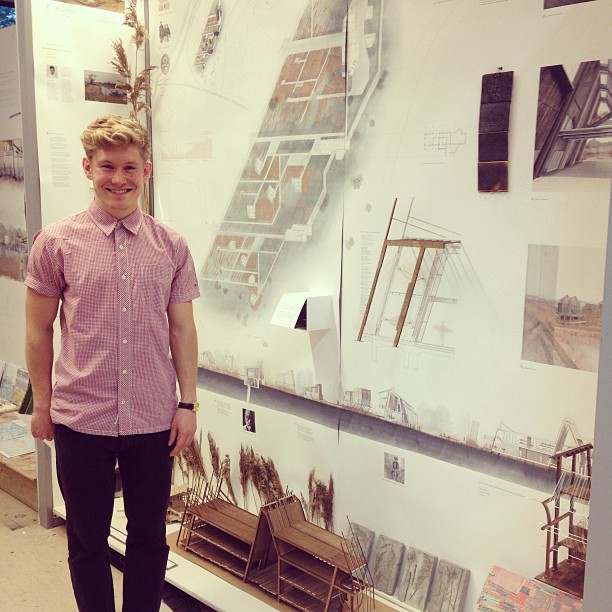I have recently graduated from the University of Nottingham with a First Class Honours in Architecture and Environmental Design [MEng]. I look forward to a summer of travelling before starting a graduate engineering role with Buro Happold in Bath .
The following text, image and video illustrate a summary of the development of my 4th year studio project which culminated in exhibiting the work in the University of Nottingham's Architecture Summer Exhibition 2013. [Please click on the images to enlarge]
The following text, image and video illustrate a summary of the development of my 4th year studio project which culminated in exhibiting the work in the University of Nottingham's Architecture Summer Exhibition 2013. [Please click on the images to enlarge]
My exhibition bay at the University of Nottingham Summer Exhibition
I wrote the following programmatic narrative to aid the design process and help explain the inspiration and stories behind the design. Watch and listen for a quick summary of the project [if you wish to see more information and detail, please scroll down] Thank you to Tameside Local Studies Archive for the local coal mining photographs. These run alongside my personal artwork, photographs and exhibition drawings.
Watch and listen
AMELIORATION OF THE MINES
The location of the project lies 10km East of Manchester in a town called Dukinfield. The town sprung in to life in the 19th century when the coal and cotton industry enjoyed a symbiotic relationship to put this small Lancashire town on the map. 6 local coal mines supplied coal along the newly established canal network to the hungry cotton mill steam engines and local fireplaces of Dukinfield and Manchester. The coal mining community was famous for its hardwork, camaraderie and drinking:
“Another thing, of course, in the mining communities which you must respect is their capacity for beer – very important.”
Dukinfield brewed very strong ale which was very popular with the miners
1.1 Vision + Ambition
After completing significant background research and site analysis, the project was set out with the following vision and ambition. Amelioration of the Mines seeks to provide an alcohol rehabilitation centre for the modern population of Dukinfield on the old site of Astley Deep Pit, the largest of the old local coal mines. The unique aspect of this rehabilitation is the programme which embodies the fantastic camaraderie and physical work of the coal miners to rehabilitate the land of the old mine and transform this scar in the landscape into a flourishing sanctuary Furthermore, to allow the facility to gain an identity and income, the residents will learn the skills to produce an organic ginger cordial, all made from produce grown on site. This is in turn will re-establish the local Barretts Company legacy of manufacturing soft drinks and their famous ginger cordial recipe.
To purify the polluted water in the mine, the residents will establish a passive treatment strategy of slowly transforming the landscape into wetlands and reed beds. Reed beds are well known for their water purifying properties and will add to the restoring natural landscape. Reeds will be used to maintain the various forms of private spaces required for this programme through natural screens and barriers between public and private spaces. Furthermore, boiling the Phragmites Australis reed root produces a sugary syrup that will become a fundamental ingredient of the organic ginger cordial.
Barrett's Soda Water produced a very well known ginger cordial recipe
The traditional timber headstocks were a great form of inspiration
Initial concept image of men working in the land and dormitories resting high above the water
Photograph of the emerging wetlands on the site
The initial stages of the project comprised of research into the geographical, industrial and social history of Dukinfield. This involved interviews with local residents / ex coal miners / alcohol rehabilitation workers and wildlife experts.
Extensive mapping, weather analysis and heating / cooling requirements were calculated. This informed the exploration of passive and active heating and ventilation strategies. Consequently, comfortable internal conditions could be designed and maintained sustainably.
Alcohol Consumption Data for Tameside
Existing building mapping analysis
Annual Average Wind Speed vs Average Temperature Graph
Sketch Sections
Resident Dormitory Section
Accommodation for the residents in alcohol rehabilition: I designed the spaces to sit within the wetlands to produce a calming environment and give them privacy between the rehab sessions. The reed beds and dormitories have been designed to give the resident different levels of privacy as they progress through the rehabilitation programme.
The following image reveals the construction of the dormitories: The prefabricated timber structure has been designed to attach to the top of floats and allow the dormitories to sit above the water and avoid flooding at all times.
Exploded Axonometric: Dormitory Construction
Dormitory Elevation
The Master plan illustrates the separation of the buildings. This was designed to give the residents privacy and outdoor space between activities. Furthermore, this allowed the public spaces to be safely separated from the treatment rooms and resident accommodation.
Master Plan
Ground Floor Plan of Resident Accommodation
Ground Floor Plan of Ginger Cordial Factory
Long Section
Closer view of the long section
Construction Section: Ginger Cordial Factory South Facade
External View of dormitories
External View of Cordial Factory
Internal View of Cordial Factory
The work above is a small sample of what was exhibited at the University of Nottingham Architecture Summer Exhibition. If you would like any further information on the work, please don't hesitate to contact me: wtaholley@hotmail.com


























No comments:
Post a Comment